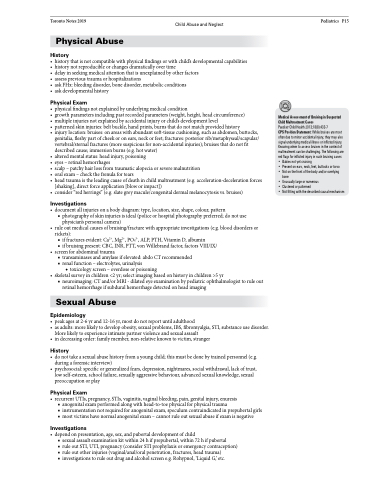Page 1049 - TNFlipTest
P. 1049
Toronto Notes 2019 Child Abuse and Neglect Physical Abuse
History
• historythatisnotcompatiblewithphysicalfindingsorwithchild’sdevelopmentalcapabilities • historynotreproducibleorchangesdramaticallyovertime
• delayinseekingmedicalattentionthatisunexplainedbyotherfactors
• assessprevioustraumaorhospitalizations
• askFHx:bleedingdisorder,bonedisorder,metabolicconditions • askdevelopmentalhistory
Physical Exam
• physicalfindingsnotexplainedbyunderlyingmedicalcondition
• growthparametersincludingpastrecordedparameters(weight,height,headcircumference)
• multipleinjuriesnotexplainedbyaccidentalinjuryorchild’sdevelopmentlevel
• patterned skin injuries: belt buckle, hand prints, burns that do not match provided history
• injurylocation:bruises:onareaswithabundantsoft-tissuecushioning,suchasabdomen,buttocks,
genitalia, fleshy part of cheek or on ears, neck or feet; fractures: posterior rib/metaphyseal/scapular/ vertebral/sternal fractures (more suspicious for non-accidental injuries); bruises that do not fit described cause; immersion burns (e.g. hot water)
• altered mental status: head injury, poisoning
• eyes–retinalhemorrhages
• scalp–patchyhairlossfromtraumaticalopeciaorseveremalnutrition
• oralexam–checkthefrenulafortears
• headtraumaistheleadingcauseofdeathinchildmaltreatment(e.g.acceleration-decelerationforces
[shaking], direct force application [blow or impact])
• consider“redherrings”(e.g.slategreymacule/congenitaldermalmelanocytosisvs.bruises)
Investigations
• documentallinjuriesonabodydiagram:type,location,size,shape,colour,pattern
■ photography of skin injuries is ideal (police or hospital photography preferred; do not use
physician’s personal camera)
• ruleoutmedicalcausesofbruising/fracturewithappropriateinvestigations(e.g.blooddisordersor
rickets):
■ if fractures evident: Ca2+, Mg2+, PO43-, ALP, PTH, Vitamin D, albumin
■ if bruising present: CBC, INR, PTT, von Willebrand factor, factors VIII/IX/
• screenforabdominaltrauma
■ transaminases and amylase if elevated: abdo CT recommended ■ renal function – electrolytes, urinalysis
◆ toxicology screen – overdose or poisoning
• skeletalsurveyinchildren<2yr;selectimagingbasedonhistoryinchildren>5yr
■ neuroimaging: CT and/or MRI - dilated eye examination by pediatric ophthalmologist to rule out retinal hemorrhage if subdural hemorrhage detected on head imaging
Sexual Abuse
Epidemiology
• peakagesat2-6yrand12-16yr,mostdonotreportuntiladulthood
• asadults:morelikelytodevelopobesity,sexualproblems,IBS,fibromyalgia,STI,substanceusedisorder.
More likely to experience intimate partner violence and sexual assault
• indecreasingorder:familymember,non-relativeknowntovictim,stranger
History
• donottakeasexualabusehistoryfromayoungchild;thismustbedonebytrainedpersonnel(e.g. during a forensic interview)
• psychosocial:specificorgeneralizedfears,depression,nightmares,socialwithdrawal,lackoftrust, low self-esteem, school failure, sexually aggressive behaviour, advanced sexual knowledge, sexual preoccupation or play
Physical Exam
• recurrentUTIs,pregnancy,STIs,vaginitis,vaginalbleeding,pain,genitalinjury,enuresis
■ anogenital exam performed along with head-to-toe physical for physical trauma
■ instrumentation not required for anogenital exam, speculum contraindicated in prepubertal girls ■ most victims have normal anogenital exam – cannot rule out sexual abuse if exam is negative
Investigations
• dependonpresentation,age,sex,andpubertaldevelopmentofchild
■ sexual assault examination kit within 24 h if prepubertal, within 72 h if pubertal
■ rule out STI, UTI, pregnancy (consider STI prophylaxis or emergency contraception) ■ rule out other injuries (vaginal/anal/oral penetration, fractures, head trauma)
■ investigations to rule out drug and alcohol screen e.g. Rohypnol, ‘Liquid G,’ etc.
Pediatrics P15
Medical Assessment of Bruising in Suspected Child Maltreatment Cases
Paediatr Child Health 2013;18(8):433-7
CPS Position Statement: While bruises are most often due to minor accidental injury, they may also signal underlying medical illness or inflicted injury. Knowing when to assess bruises in the context of maltreatment can be challenging. The following are red flags for inflicted injury in such bruising cases: • Babiesnotyetcruising
• Presentonears,neck,feet,buttocksortorso • Notonthefrontofthebodyand/oroverlying
bone
• Unusuallylargeornumerous
• Clustered or patterned
• Notfittingwiththedescribedcausalmechanism


